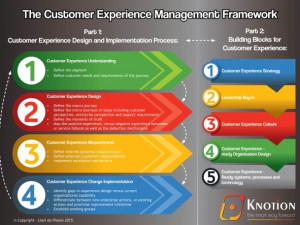Johannesburg, 27 Sep 2016
According to Forrester Research, we have entered the Age of the Customer: manufacturing strength, distribution power, and information mastery have started to dissolve as competitive boundaries, and have largely become commoditised. As customers' expectations increase for choice between products, services and preferred channels, customer service excellence is becoming increasingly important to all enterprises that deliver a product or a service to its customers.
The customer experience challenge is one faced by all services companies. As these companies face increased competition and declining profits, they have to focus on customer experience improvement to differentiate their services from their competitors. As customer choice becomes the main differentiator for companies, they start to realise that they need to shift their focus to customer experience management (CEM).
Customer experience management has become a new buzzword - and most companies do not understand all that it entails. Also, many consultancies offer only a piece of the puzzle and not a holistic solution to CEM.
So what does customer experience management entail? Let's start with what it is not: Customer experience management is not only customer journey mapping, implementing a Voice of the Customer (VOC) program, or closed loop customer feedback. It is not only about implementing a customer analytics or monitoring solution, or about appointing a Chief Customer Experience officer. It is about all of that, and more. Bernd Schmitt offered the following definition in his book Customer Experience Management: A Revolutionary Approach to Connecting with Your Customers: "Customer experience management represents the discipline, methodology and/or process used to comprehensively design and manage a customer's cross-channel engagement with a company, product, brand or service - in order to meet or exceed customer expectations, thereby increasing satisfaction, loyalty and advocacy."
Implementing a capability for good customer experience management in an enterprise is not a simple task. Customer experience does not improve until it becomes a top priority, and until a company's work processes, systems, strategy, structure, and culture change to reflect this.
How do we navigate this complex landscape? By going back to the basics.
Enterprise Architecture (EA) is a tool that helps us define the building blocks of an organisation, linking these building blocks to a company vision and helping the organisation to align its internal operations to its strategy. Traditionally, EA was very much inside-out focused, concentrating on the internal organisation, its processes, data, applications, and technology. In order to remain competitive in this Age of the Customer we need to approach the building blocks from a different angle, from the outside-in. For this, we need a new approach to architecture.
Knotion Consulting has developed a framework for customer experience management, which it uses as a starting point for outside-in architecture. It encompasses the following:
(1) Understand your customers and their needs and requirements.
(2) Define the current customer journey along all the touch points of the customer with the company. Identify the customers' emotions along these steps in their journey and identify the "moments of truth" or possible points of failure. Use these to design a target customer-centric journey aligned to the customers' needs and requirements.
(3) Define appropriate measurements to measure the success of that journey both from an internal company perspective, as well as from an external, or customer perspective.
(4) Ensure that the optimised customer journey is implemented in the organisation through proper identification and prioritisation of improvement initiatives.
The framework also suggests five building blocks that the organisation has to implement to ensure that customer-centricity is intrinsic in the organisation and addressed holistically. These are:
(1) Define and implement a customer experience strategy.
(2) Ensure that the leadership team has bought in to customer experience as a priority.
(3) Implement a culture of customer-centricity in the organisation along with all employees.
(4) Ensure that the organisation's design and structure enables customer-centricity.
(5) Align the organisation's systems, processes, and technology towards customer-centricity.
Below is the customer experience management framework:

Instead of focusing on business process mapping as a traditional EA tool, we use tools such as the customer canvas, customer journey mapping, moment mapping, service blueprinting, and fail-saving to identify and unpack the requirements of the customers on every step of the journey with the company when we create the baseline or As-Is process models. Using this information, we can then design our target or To-Be architecture models from the outside-inwards. If we understand what our customers want, their preferred channels and touch points, and we design accordingly, we can align the internal processes, information, information systems, data and technology to support this.
This process leads to a customer-centric, relevant and reliable architecture that is the foundation of your business.
Author Liezl du Plessis
Liezl du Plessis is a Business Architect at Knotion Consulting. She is a TOGAF certified Enterprise Architect with a focus on Customer Experience Management (CEM). Liezl completed her Masters' in Industrial Engineering with a dissertation in Customer Experience Management in Telecoms. Knotion is a Johannesburg-based enterprise architecture consultancy, providing TOGAF as well as ArchiMate training.
Share